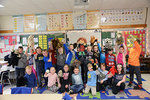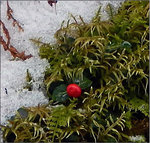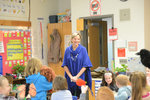 Narrowsburg
NarrowsburgLight Rain Fog/Mist, 43°
Wind: 8.1 mph
 Narrowsburg
NarrowsburgDAMASCUS, PA — A slate of colorful characters visited Mrs. Redick’s second-grade at Damascus School Tuesday morning. Notable guests included Hobo the Spider, a coyote named Rover and …
Stay informed about your community and support local independent journalism.
Subscribe to The River Reporter today. click here
This item is available in full to subscribers.
Please log in to continue |




DAMASCUS, PA — A slate of colorful characters visited Mrs. Redick’s second-grade at Damascus School Tuesday morning. Notable guests included Hobo the Spider, a coyote named Rover and perhaps the students’ favorite: Ed Wesely.
Wesely, local monarch butterfly expert and longtime River Reporter columnist, is a familiar face in the classroom, made clear by the warm welcome he received as he entered, lugging an acoustic guitar in one hand and a large blue bag in the other.
“Do you know what’s in this bag?” he asked his engaged audience.
Many visibly struggled not to hop out of their chairs, as others responded with knowing excitement: puppets.
Wesely brought 21 puppets in all, just enough for every child to take part in the day’s first activity. With the cast of farm, forest and winged critters ready, Wesely picked up his guitar and sang an impromptu tune that incorporated every puppet in the room.
When the performance was over, the class had important business to take care of. They wanted to know what had become of Tiny.
Earlier in the school year, Wesely—who spent years raising monarch butterflies in a barn on his property—came to class with butterfly eggs. This past September, the class took care of the eggs as they transitioned from caterpillars to monarch butterflies. One of the monarchs had far smaller wings than any of the others. This was Tiny.
Tiny presented a dilemma. Unsure if he could survive with his diminutive wings, the kids debated: should they set him free, or keep him as a sort of classroom pet?
 At first, almost all of the students agreed, they would keep him as a pet. But then one student raised her hand. “You can’t be a butterfly inside a cage,” she said. And so they set him free.
At first, almost all of the students agreed, they would keep him as a pet. But then one student raised her hand. “You can’t be a butterfly inside a cage,” she said. And so they set him free.
“You can’t be a butterfly inside a cage." And so they set him free.
For weeks after releasing Tiny, Wesely checked daily and found the little monarch feasting on the nectar from flowers alongside much larger butterflies. But one day, as the temperatures began to drop, the community of pollinators were gone, along with Tiny.
“I think that means he flew to Mexico with the others,” Wesely happily told the class.
He asked the class if anybody remembered anything about their winged friend. Hands shot up rapidly. As it turned out, the students knew a lot.
The students remembered how to tell a male butterfly from a female, what kind of food they eat and why a few of the larger monarchs needed tags, to track their progress as they migrated south. Wesely was delighted.
“You all remember more than I do,” he said.
The second grade teacher, Judy Redick, said that Wesely provides a beneficial supplement to the students’ regular curriculum—his visits provide interactive learning, not often found in textbooks.
“It’s a great learning experience for the students,” Redick said, adding that it has taught her a lot about the lifecycle of a butterfly as well. “Mr. Wesely has been coming in for about the past eight years, and he really goes above and beyond. They love him.”
Next on the day’s program, Wesely had a Christmastime story he had penned himself. The plot involves a mouse named Percival and a tiny partridge berry with two green leaves, resembling a Christmas wreath. Percival’s first instinct was to eat the berry, as he had done many times before, but then he stopped and realized that this small, berry-laden wreath was the most beautiful thing in the forest. The mouse gathered his friends around, and they all agreed that they had never seen anything so pretty, “not even Tom chickadee has, who flies everywhere.” And so, the mice agreed to save the Christmas wreath.
The mice’s tough decision, Wesely told the students, was similar to the one they faced regarding Tiny.
At quarter to ten, it was time for Mrs. Redick’s class to get on with their next lesson of the day. As he began to pack up his puppets, a chorus of voices rose asking, “Can I help?”
Several boys and girls carried Wesely’s belongings for him, while two others held open the door.
“Goodbye and thank you, Mr. Wesely!” they called as he left.
He would be back soon, perhaps with more puppets, and surely with more lessons to teach.
Mice and a Berry
By Ed Wesely
One day, when Percival Mouse came by, he saw something red where snow was melting. It was a Partridge berry about the size of his big toe…. with two green leaves, like a pretty wreath. Hungry though he was, Percival thought “Wait a minute - this is very pretty.” And he later told Minerva mouse, “I’ve seen something pretty in a place near the creek, where beech nuts drop.” And Minerva told Minnie Mouse, who told Hermione who told Ambrose Mouse. ‘Til by late in the day a crowd was gathered, including Tom Chickadee who saw the berry, but dared not fly down to eat it. It was the prettiest thing in the forest. “Think a minute, ” said Ambrose Mouse, to everybody: “ We’ve seen a lot of wreaths at farms, but nothing this pretty…. not even Tom chickadee has, who flies everywhere. “I say we must keep it as a Christmas wreath, and a special sign of a special place . “. Which is what they did. Including Tom who kept watch until spring from a hidden perch.
Here's a recording of Ed Wesely reading his short 1984 article for TRR about meeting Jimmy Carter on a quiet day on the Delaware River.
Comments
No comments on this item Please log in to comment by clicking here